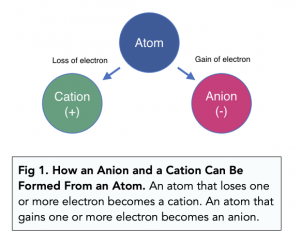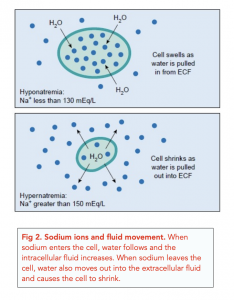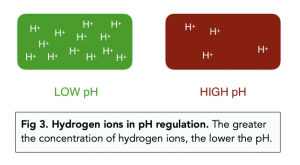Inorganic Ions (A-level Biology)
Inorganic Ions
Ions
- An ion is a particle with an electric charge. A particle can be an atom or a group of atoms.
- Ions can be positive or negative.
-
- A cation is a positively charged ion.
- An anion is a negatively charged ion.
-

- Ions can be organic or inorganic.
-
- An organic ion contains carbon.
- An inorganic ion doesn’t contain carbon.
-
- Ions are formed when an atom transfers its electrons to another atom. The atom which loses electrons becomes a cation. The atom which gains the electrons is called an anion.
- Some examples of inorganic ions include: Sodium (Na+), Potassium (K+), Calcium (Ca2+), Chloride (Cl-), Iron (Fe2+ or Fe3+)
Inorganic Ions in the Body
- Inorganic have key biological functions. Many different organic ions can be found in organisms and play an important role in organisms. Inorganic ions can be found in the cytoplasm and body fluids of organisms.
- Ion concentrations vary. Some ions are found in high concentrations, and others in low concentrations. The body carefully regulates ion levels through organs such as the kidney.
Cations
Calcium Ions
- Calcium ions (Ca2+) are important for physiological functions.
- Helps insulin be released from the pancreas.
- Responsible for transmitting nerve impulses.
- Calcium ions can be cofactors for various enzymes. Enzymes involved in the blood clotting cascade often need calcium ions as a cofactor.
- Bone formation requires calcium. Proper bone formation cannot occur without calcium, and bones are the major store site for calcium in the body.
- Calcium makes up the middle lamellae in plants. The middle lamella is a layer in plant cells that joins two plant cell walls together. It is made up of calcium and magnesium ions.
Sodium Ions
- Sodium ions (Na+) are key for co-transport. Sodium helps molecules such as glucose and amino acids cross the cell membrane in order to enter a cell through a process known as co-transport.
- Sodium and potassium are key in the nervous system. Sodium and potassium ions are very important in the nervous system and communication between neurones.
- Sodium is crucial for fluid regulation. Movement of water follows the movement of salt (i.e. sodium). When sodium ions leave the cell, so does water, and the volume of extracellular fluid increases. Conversely, when sodium ions reenter into cells, water follows, and the volume of extracellular fluid decreases.

Potassium Ions
- Potassium ions (K+) are important for nerve impulses and fluid balance. Just like sodium, it helps generate nerve impulses. It also plays the same role as sodium in fluid balance, i.e. its movement is tightly controlled by the body to regulate the amount of fluids in intracellular and extracellular compartments.
- Potassium helps muscles contract. Potassium is essential for the contraction of muscle fibres, therefore, the levels of potassium can affect how well key muscular organs can function e.g. the heart.
- Photosynthesis requires potassium. Potassium is responsible for the opening and closing of the stomata in leaves, thus potassium controls how much CO2 is being taken in by the plant.
Hydrogen Ions
- Hydrogen ions (H+) help control pH in digestion. Hydrogen ions are also important for maintaining the low pH of the gastric juices within the stomach which is important for digestion.
- Hydrogen ions also help in respiration. Hydrogen ions play a very important role in ATP synthesis in the mitochondria during cellular respiration.

Magnesium Ions
- Magnesium ions (Mg2+) are important cofactors. They act as cofactors for enzymes such as amylase and lipase which breakdown glucose and fats.
- Magnesium ions are essential for photosynthesis. They are necessary for the production of chloroplasts in plants, which are organelles responsible for carrying out photosynthesis.
Ammonium Ions
- Ammonium ions (NH4+) are key ions in plants. Plants absorb ammonium from the soil, and is able to use the nitrogen from it to synthesise necessary biological molecules such as nucleic acids and amino acids.
Anions
Nitrate Ions
- Nitrate ions (NO3-) are key ions in plants. They are absorbed from the soil just like ammonium ions and used in the same manner.
Hydrogencarbonate Ions
- Hydrogencarbonate ions (HCO3-) maintain blood pH levels. Also known as the bicarbonate ion, it works as a buffer in the blood, keeping its pH levels within a narrow range.
Chloride Ions
- Chloride ions (Cl–) have various physiological roles.
- Keeps the pH level of blood constant when gas exchange occurs.
- Responsible for transmitting certain nerve impulses.
- Is a cofactor for the digestive enzyme amylase.
Phosphate Ions
- Phosphate ions (PO43-) are found in phosphate groups. Phosphate ions are often found attached to many biological molecules as phosphate groups.
- Phosphate groups are found in DNA, RNA, and ATP. In ATP the energy is stored in the phosphoanhydride bonds between the three phosphate groups which make up ATP.
- Phosphate groups drive phosphorylation. Phosphate groups can be added to molecules to make them more reactive through phosphorylation.
- Phosphate groups are found in phospholipids. The phospholipids are a key component of cell membranes, forming the phospholipid bilayer.
Hydroxide Ions
- Hydroxide ions (OH–) are bases. When there is a high concentration of hydroxide ions in a solution, it will make the solution alkaline.
Overall, we have covered the definition of inorganic ions in A-Level Biology and the examples of inorganic ions.
FAQs
Inorganic ions are charged particles that are not part of a larger organic molecule. These ions can be positively charged (cations) or negatively charged (anions) and play important roles in biological processes such as muscle contraction, nerve impulses, and fluid balance.
Some common inorganic ions in the human body include sodium (Na+), potassium (K+), calcium (Ca2+), and chloride (Cl-).
Inorganic ions play crucial roles in a variety of biological processes such as maintaining fluid balance, transmitting nerve impulses, and contracting muscles. For example, sodium and potassium ions are involved in maintaining the resting potential of neurons and the contraction and relaxation of muscle fibers. Calcium ions are important for muscle contraction, blood coagulation, and transmitting nerve impulses.
The main difference between organic and inorganic ions is the presence of carbon atoms in the molecule. Organic ions contain carbon atoms bonded with other elements, while inorganic ions do not contain carbon atoms.
Organic ions are typically derived from living organisms and are often involved in biochemical reactions. Examples of organic ions include amino acids, nucleotides, and acetylcholine.
In contrast, inorganic ions are derived from non-living sources and are typically involved in more basic chemical reactions. Examples of inorganic ions include sodium (Na+), chloride (Cl-), and potassium (K+).
Another difference between organic and inorganic ions is their solubility in water. Organic ions are generally less soluble in water than inorganic ions, which are often highly soluble due to their ionic charge.
Overall, the distinction between organic and inorganic ions is based on the presence or absence of carbon atoms in the molecule. This fundamental difference leads to differences in the chemical properties and reactivity of these ions.
The balance of inorganic ions in the human body is crucial for normal physiological functioning. An imbalance of ions can lead to conditions such as hyponatremia (low sodium levels) or hyperkalemia (high potassium levels), which can have serious consequences for health. Maintaining the correct balance of ions is therefore important for overall health and well-being.
Inorganic ions are regulated by various mechanisms in the human body, including the action of hormones, the permeability of cell membranes, and the action of ion pumps. For example, the hormone aldosterone regulates the balance of sodium and potassium ions in the body, while the sodium-potassium pump helps maintain the correct balance of these ions across cell membranes.
Inorganic ions play important roles in the digestion of food. For example, hydrochloric acid (HCl) is produced in the stomach and helps to break down food, while sodium ions and chloride ions are involved in the production of digestive juices and the absorption of nutrients from the intestines.
Inorganic ions play important roles in photosynthesis, the process by which plants convert light energy into chemical energy. For example, calcium ions help regulate the opening and closing of stomata, which control the exchange of gases in the leaves. Magnesium ions are involved in the process of chlorophyll synthesis and function as a cofactor in the reaction center of photosystems.






Still got a question? Leave a comment
Leave a comment